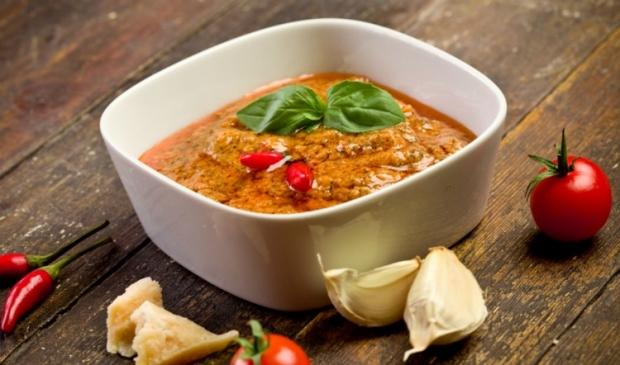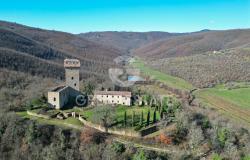When we hear the word pesto, most of us think of the Genovese variety, a blend of seven ingredients-- basil, pine nuts, garlic, olive oil, salt and grated cheeses-- but there are hundreds of versions throughout Italy. Pesto, from the word pestare, which means to crush or pound and gives us the word pestle, dates back to ancient Roman times. Moretum--cheese ground with garlic, olive oil, vinegar and herbs—was a popular ancient Roman pesto eaten with bread. A recipe for it can found in De Re Rustica, a first century series of books on agriculture by Lucius Junius Moderatus Columella.
Throughout Italy there are hundreds of pesto recipes featuring all sorts of herbs (like marjorum, mint, sage and oregano); vegetables (such as arrugula, egg plant, chicory, peas, escarole and zucchini; and nuts (like almonds, walnuts, pistachios and hazelnuts).

Each region has many classic pesto dishes, like Liguria’s Marjorum pesto, which is classically served with round corzetti pasta and Emilia-Romagna’s Pesto Modenese, made with lard, rosemary, garlic and Parmigiano Reggiano.

Sicily has several delicious pestos, which feature the island’s specialty ingredients like capers, oranges, lemons and Bronte pistachios. Pesto alla Trapanese, recipe below a decendant of the Genoa version. Genovese ships stopping in the port of Trapani brought the Ligurian recipe with them, which the Tranpanese sailors modified using local produce: almonds and tomatoes. Traditionally pesto alla trapanese is served with a homemade fresh pasta specialty of Sicily called “i busiati”--thin sections of pasta dough rolled around a knitting needle, called “busi,” which gives the pasta its name.

Pesto alla Trapanese is made with tomatoes, which botanically speaking is a fruit, and this is not the only fruit pesto of Sicily. Pesto agli Agrumi, recipes below pesto made with various citrus fruit, has been popularized by Sicilian-born chef Filippo la Mantia. Try his orange-almond pesto, which has a perfectly balanced taste with zesty, salty tang of capers or the superbly different and light lemon-fennel pesto. In Sicily they often top this pasta with fish, like shrimp, octopus or tuna, making a one-dish main course meal.

Another classic pesto is called Pesto Povero recipe below. Popular in the countryside of Sicily’s Agrigento province, it’s called “poor” because it is made mostly with herbs and vegetables, plentiful in everyone’s garden. To make enough delicious pesto for four takes just six almonds! This is a highly aromatic pesto, with wave after wave of flavor---basil hits first, then rosemary, with a delightful finish of mint and lemon.
Sicily is the only region in Italy that cultivates pistachios, with the most prized coming from Bronte in the province of Catania. Each year the town holds a Pistachio Festival--Sagra del Pistacchio---from late September through the beginning of October where visitors are treated to tastings of all sorts of dishes made with pistachios including sausages, liqueurs, and many desserts. Pesto al Pistachio recipe below combines pistachio with mint to make an especially rich pesto with a lovely freshness. As an added plus, pistachios, according to the Italians, may even be an aphrodisiac! “Wonderful in reawakening venereal appetites,” writes a Bolognese physician in 1612 and an 18th century Venetian herbalist claims they “excite the fervors of Venus.” While I’m not positive about the aphrodisiac claims, I am sure this dish will get your taste buds tingling!
No matter what type of pesto you make, Italian chefs all agree that the secrets to good presto are
- 1- Use well dried herb leaves. After washing them pat them dry with a linen or cotton cloth or paper towel
- 2- Grind the herbs very quickly
- 3- Use the pesto immediately.
-----
Pesto alla Trapanese
Tomato-Almond Pesto of Trapani
From: Pasta Modern (Stewart, Tabori & Chang)
Serves 4
The perfect way to show off summer’s ripe tomatoes to their best! Almonds impart a creamy sweetness that goes well with the acidic tang of fresh tomatoes.
1/2 cup blanched toasted almonds
2 garlic cloves
Olive oil
1 bunch fresh basil
3 large ripe tomatoes
1 pound busati or any pasta shape
Salt and freshly ground black pepper
Toasted fresh breadcrumbs
In a mortar and pestle or a small food processor, grind the almonds and garlic until fine, then stream in 4 tablespoons olive oil. Lastly, grind in most of the basil leaves. Taste and adjust seasonings, adding more basil, garlic or olive oil. Put the pesto into a serving bowl.
Plunge the tomatoes into boiling water for one minute then into cold water. Remove the skin, deseed and dice. Stir the tomatoes into the pesto, reserving a bit for garnish.
Cook the pasta until al dente in boiling, salted water. Drain and toss with the pesto. Season to taste with salt and freshly ground black pepper, and top with toasted breadcrumbs and the reserved tomatoes.
----
Pesto agli Agrumi
Almond-Orange Pesto
Courtesy Chef Filippo la Mantia
Serves 4
Like summer on a fork!
2/3 cup blanched almonds
1/2 bunch fresh basil
2 naval oranges
1/3 cup salted capers, rinsed
Olive oil
Salt
1 pound any pasta shape
Grind the almonds in a small food processor or mortar and pestle until fine. Add the basil leaves and grind into a paste.
Using a very sharp knife, and working over a plate to collect the juices, cut off the skin and white pith of the oranges and discard. Separate the orange sections, cutting or peeling off the membranes between the sections. Add the orange sections, any collected orange juice, capers, and 3 tablespoons of olive oil to the almond mixture and grind until fine, adding more olive oil if too thick. Season to taste with salt.
Cook the pasta in salted water until al dente. Drain and toss with the pesto. Serve hot or at room temperature.
----
Pesto agli Agrumi 2
Lemon-Fennel Pesto
Courtesy Chef Filippo la Mantia
Serves 4
1/3 cup blanched almonds
1 lemon
1 fennel bulb, including fronds, chopped
1 small wild fennel bulb, including fronds, chopped
2 tablespoons salted capers, rinsed
1/2 bunch fresh mint
1 bunch fresh basil
Olive oil
Salt
1 pound any shape pasta
Seafood, optional
Grind the almonds in a mortar and pestle, clean coffee grinder or small food processor until fine.
Using a very sharp knife, and working over a plate to collect the juices, cut off the skin and white pith of the lemon and discard. Separate the lemon sections, cutting or peeling off the membranes between the sections.
Put the fennel, lemon pieces, and any collected lemon juice into a food processor and grind until fine. Add the finely ground almonds, wild fennel, if using, capers, mint leaves, basil leaves, and 3 tablespoons olive oil and process until it resembles cooked oatmeal, adding more olive oil if too thick. Season with salt.
Cook the pasta in salted water until al dente. Drain and toss with the pesto. Serve with cooked seafood, if you like.
---
Pesto Povero
Poor Man’s Pesto
From: Pasta Modern (Stewart, Tabori & Chang)
Serves 4
1 1/3 cup assorted fresh herbs, leaves only, including basil, parsley, mint, and a bit of sage and rosemary
Zest of 1/2 lemon
1 small tomato, diced
1 garlic clove
6 toasted almonds
Olive oil
Salt and black pepper
1 pound any shape pasta
Pecorino or caciocavallo cheese
Put the herbs, zest, tomato, garlic and almonds in a food processor or mortar and pestle and grind until smooth. Slowly steam in 5 tablespoons olive oil until creamy. It will be very dense. Season to taste with salt and freshly ground black pepper.
Cook the pasta in salted water until al dente. Drain and toss with the pesto, adding a few tablespoons of the cooking water, if dry. Top with a drizzle of olive oil and shaved or grated cheese to taste.
----
Pasta al Pistachio
Mint Pistachio Pesto
From: Pasta Modern (Stewart, Tabori & Chang)
Serves 4
1 pound casarecce or any shape pasta
Salt
1/3 cup shelled unsalted pistachios
1 bunch mint
1 bunch basil
1/4 cup grated aged caciocavallo or pecorino cheese
1 garlic clove
Olive oil
Black pepper
Cook the pasta in boiling, salted water until al dente.
Meanwhile, in a small food processor or a mortar and pestle, grind the pistachios until fine. Next grind in most of the mint and basil, then the cheese, and garlic. Slowly stream in about a 1/4 cup of oil until creamy. Taste and grind in more mint or basil, if needed, or reserve the remaining leaves as garnish.
Drain the pasta and toss with the pesto. Season to taste with salt and freshly ground pepper and top with more cheese, if you like, and the reserved basil and mint leaves.













